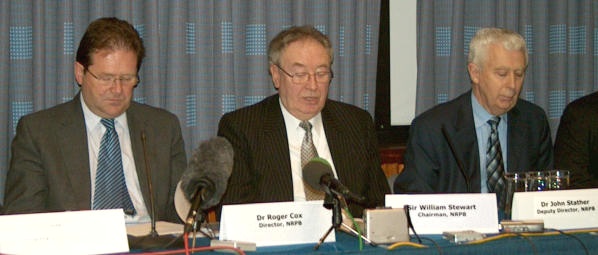 |
 |
|
 |
 |
About Us | Contact |
|
|
14/01/2005 - Stewart Report (revised)
Summary:The second Stewart Report made several recommendations about tightening up mast network guidelines and protecting the vulnerable. Sir William Stewart repeated the advice from the expert group in 2000 that children should use a mobile phone for essential calls only. 5 million children in the UK have a mobile phone. Sir William Stewart (head of the NRPB) summarised "Because of the current uncertainties we recommend a continued precautionary approach to the use of mobile phone technologies. Because everyone has a mobile phone does not necessarily mean that they are without potential adverse health effects." Main recommendations in line with the precautionary approach. The NRPB Press Release highlighted:
The NRPB Board welcome the government intention to increase the penalty for using a mobile phone while driving to 3 penalty points and a £60 fine. They recommend that OFCOM ensures that the information on the surveys on its sitefinder website be more readily accessible, easily interpretable by members of the public and kept up to date. The report acknowledges the Swedish and German studies and the AGNIR review (2003) showing evidence for potential health problems from the technology. (Executive Summary [ES] paragraph 13). The NRPB Board recommends further research (with government and industry funding) including:
Powerwatch commentIn response to public concern, the NRPB investigated 20 base stations to establish public exposure levels. Astonishingly, they specifically chose to exclude the low-height high-power base stations that radiate people most highly and instead focussed on low power masts, and concluded that exposures are no more than 8% of guidelines (which we think are set far too high)! ES (Executive Summary) paragraph 41 insists that possible health concerns be a national, rather than local, consideration with respect to base station planning applications. Whilst the Office of the Deputy prime Minister supports concerns about health effects as a legitimate consideration and the judiciary overturn cases hinging on such concerns, the general public are left dazed by the double think standards that make these contradictions possible. ES paragraph 42 reads "The Board believes that it is timely for there to be set in place a much clearer and more readily understandable template of protocols and procedures to be followed by local authorities and phone operators across the UK". What should the restrictions be with respect to microcell and picocell equipment attached to buildings or on free standing "street furniture"? The controls over these developments seem both very weak and obscure and open to unacceptable local variation. The call for 'an open and transparent process' with respect to planning applications (ES paragraph 43) is certainly a welcome recommendation. We are still concerned that it is being stated that TETRA base stations do not pulse. The definition of signal modulation seems to have changed in order to exclude TETRA signals. This is, we, believe, misleading and inaccurate. However, the Board does suggest that "Until much more information becomes available, it would be premature to rule out the possibility of health effects on users of TETRA based equipment and believes that a precautionary approach should be adopted." (ES paragraph 54) We also welcome the recommendation that hands-free kits should be tested for their effectiveness in reducing RF radiation and that this information be readily available at point of sale. (ES paragraphs 73 & 74) |


 Sir William stated that he believed that the evidence for possible harm has become stronger in the (almost) 5 years since the publication of his original IEGMP Report. Sir William recommended that young people should be encouraged to minimise their of a mobile phone, and that children under about 10 years old should not have one. Recently the
Sir William stated that he believed that the evidence for possible harm has become stronger in the (almost) 5 years since the publication of his original IEGMP Report. Sir William recommended that young people should be encouraged to minimise their of a mobile phone, and that children under about 10 years old should not have one. Recently the